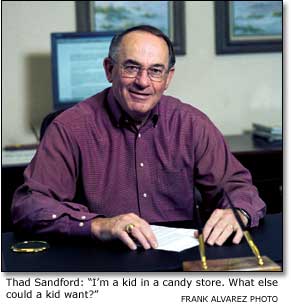| 'How do you know you’re
right?'
IDS's
Thad Sandford takes a basic approach to assembling complex
systems
BY JOEL R. NELSON

 Thad
Sandford's passion for making a difference was born of Cold War
urgency and never waned, even after the superpower standoff faded.
Propelled into engineering at the dawn of the Space Age, Sandford
devoted himself to strengthening the nation's rocket, satellite
and aircraft capabilities. Four decades later, Sandford retains
a youthful enthusiasm for his work. "I'm a kid in a candy store,"
he said, pointing to the vast array of Integrated Defense Systems
products and programs. "Look at all this. What else could a kid
want?" Thad
Sandford's passion for making a difference was born of Cold War
urgency and never waned, even after the superpower standoff faded.
Propelled into engineering at the dawn of the Space Age, Sandford
devoted himself to strengthening the nation's rocket, satellite
and aircraft capabilities. Four decades later, Sandford retains
a youthful enthusiasm for his work. "I'm a kid in a candy store,"
he said, pointing to the vast array of Integrated Defense Systems
products and programs. "Look at all this. What else could a kid
want?"
Sandford, vice president
of Engineering at Integrated Defense Systems, is responsible for providing
engineering support to a multitude of space and defense systems.
Among his priorities: ensuring
the technical integrity of the $27 billion organization's products by deploying
the right people and the right processes, making sure all risk issues are fully
understood, and fostering continuous improvement.
He takes a down-to-earth approach
to assembling some
of the world's most complex systems. "I want everyone to be able to answer one
question: 'How do you know you're right?' Good people understand personal responsibility,
and if
they can't answer the question, then something isn't right."
Much of Sandford's
attention is spent on finding, hiring
and training good people. "One of IDS' big challenges is fully staffing each
program," he said. "We must resolve our skill mix issues to meet our projected
technical and program
commitments."
Sandford has helped improve core engineering strengths by sponsoring
Web-based training and several master's degree programs. He also established
a systems engineering course for new hires and a Boeing Leadership Center training
program for more senior engineers.
Boeing's acquisition of the space and defense
business of Rockwell and Hughes Space and Communications, and the merger with
McDonnell Douglas, generated new challenges. "I want to continue bringing together
the tremendous talent
of these companies and incorporate their best practices," he
said. "We're still learning to work in a collaborative way and institute effective
interaction on scheduling and cost matters
as well as on engineering issues."
The focus on high standards is paying off.
This year, most IDS sites will achieve Level 5 of the Software Engineering
Institute's Capability Maturity Matrix, the highest standard
for software processes. Most
sites will also achieve Level 3 of the Capability Maturity Matrix Integrated
standard, a key
milestone in reaching Level 5 by 2005.
"The payoff is higher quality and reduced
cost for most of
our products," Sandford said.
Another major element of IDS' strategic push is
Future Combat Systems. "FCS is probably the U.S. Army's biggest modernization
since
the post-World War I era," Sandford said. "We're helping build a better, more
flexible,
more responsive Army."
The 63-year-old Sandford speaks in a soft drawl, the product
of his Texas upbringing. Born in Fairbanks, Alaska, he later
moved with his family to the Lone Star State. Life continued
serenely until October 1957, when the Soviet Union launched the
first man-made satellite.
"Everyone taking advanced math at my
high school was
encouraged to go into engineering," Sandford recalled. "For me, it wasn't even
a decision—I wanted to get right into
research and development."
Sandford took his math talents to Texas A&M, and after
earning his bachelor's degree in 1963, he joined the U.S. Air Force. He earned
a master's degree at the University of Tennessee Space Institute and returned
to Texas A&M for a doctorate in Aerospace Engineering. In January 1989, after
26 years and about a dozen moves, Col. Sandford retired.
"It was a great experience," he
said. The Air Force was probably the most aggressive of the services in developing
and using new technologies. "There was a real sense of
national purpose."
Seeking a new outlet for his energies, Sandford joined Rockwell
International's National Aerospace Plane Program, where he tackled the challenge
of developing a new generation of hypersonic aircraft. As in the Air Force,
the assignments came at a rapid clip, culminating in his current
position.
After
all these years, he remains awed by his surroundings. "In a lot of ways I have
the best possible job. I'm up
close with so many different, terrific things—satellites, rockets, Sea Launch,
aircraft, helicopters, and so on. Even better than the technology are the people
I work with. And I can
make a difference. That's what gives me a thrill."
| 
